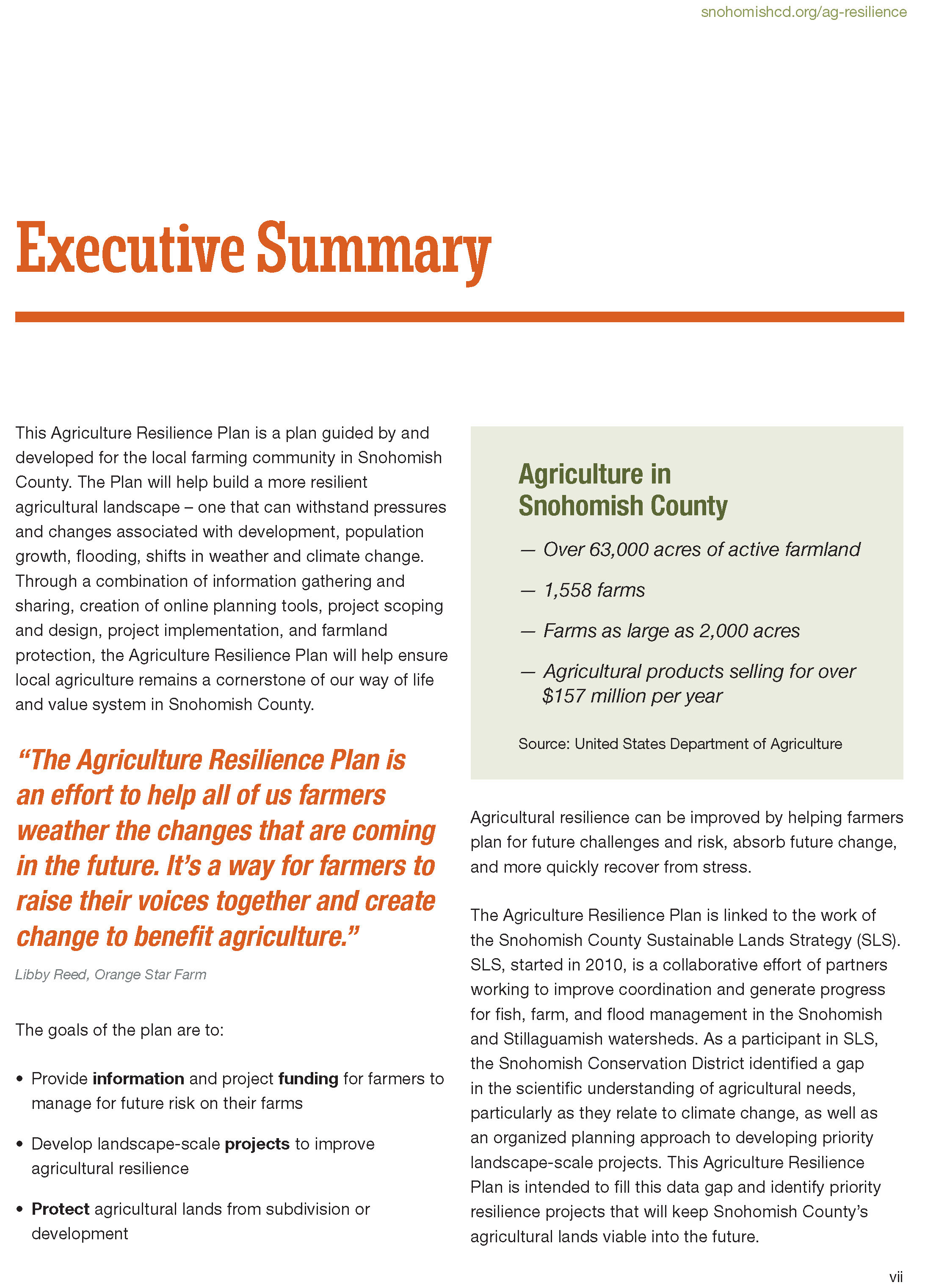Agriculture Resilience Plan for Snohomish County
/Cover, Table of Contents, Acknowledgements
Read MoreCover, Table of Contents, Acknowledgements
Read More
This Agriculture Resilience Plan is a plan guided by and developed for the local farming community in Snohomish County. The Plan will help build a more resilient agricultural landscape – one that can withstand pressures and changes associated with development, population growth, flooding, shifts in weather and climate change. Through a combination of information gathering and sharing, creation of online planning tools, project scoping and design, project implementation, and farmland protection, the Agriculture Resilience Plan will help ensure local agriculture remains a cornerstone of our way of life and value system in Snohomish County.
Since the early 1800s, agriculture has been a cornerstone of life in Snohomish County. Farms in the county have produced milk, eggs, chickens, hogs, beef, berries, row crops, hay, nursery crops, and vegetables such as corn, peas, and pumpkins. There are over 63,000 acres of active farmland in Snohomish County. These acres support 1,558 farms. While 85 percent of these farms are less than 50 acres, sizes vary and some farms are as large as 2,000 acres. Agricultural products grown on these acres sell for over $157 million per year. Agriculture is an important component of the Snohomish County community, both socially and economically.


The Agriculture Resilience Plan is intended to be the farmers’ plan – a document that reflects the interests and priorities of farmers in Snohomish County. Therefore, outreach to and engagement with the farming community has been a key component of developing this plan and will continue to be central to its implementation. Input has been solicited through the formation of a Steering Committee of local farmers, outreach to existing agricultural groups and individual farmers, and the PhotoVoice project. The next phase of plan implementation will involve robust planning conversations with groups of farmers on the landscape to develop and scope landscape-scale projects that improve agricultural viability.

Across the United States, farmland is being lost to development and conversion to other land uses. American Farmland Trust (AFT) reports that 31 million acres of agricultural land nationally were lost to development between 1992 and 2012. Such losses are usually irreversible. AFT also reports that development disproportionately affects agricultural lands—more than 70 percent of urban development takes place on agricultural land.1 These trends are reflected in Snohomish County as well. For example, the USDA Census of Agriculture reported that land in farming in Snohomish County shrank from 70,863 acres in 2012 to 63,671 acres in 2007. These numbers don’t represent the additional impact of losing larger farms to smaller, often non-commercial, farming uses. Pressures on the agricultural land base are increasing as the population of the county rises—Everett is among the fastest growing cities in Washington State—a population that could be fed by locally grown food if it was available.
Farmers are resilient; as a matter of course, farmers adjust their practices from year to year based on weather, soil conditions, and markets. Climate change impacts, however, are expected to increase pressures on agriculture in Snohomish County and may necessitate added resilience measures or changes in management altogether. Fortunately, there are a variety of tools and approaches that can be adopted to increase agricultural resilience.


To understand the impacts of climate change on agricultural land in the Snohomish and Stillaguamish River floodplains, the Snohomish Conservation District initiated technical studies on flooding, groundwater levels, saltwater intrusion, land subsidence and aggradation, and crop impacts. This chapter summarizes key findings of these technical studies. The full studies and online tools can be found on the Conservation District website at https://snohomishcd.org/ag-resilience.

The agricultural community in Snohomish County is facing many current and projected challenges associated with increased development and a changing climate. Through a robust community engagement process, farmers provided priority resilience needs for their specific reach. This chapter documents the major themes raised during this community engagement process. The chapter is followed by eleven individual Reach Summaries (Chapter VII) that characterize existing farming and infrastructure, projected impacts to agricultural viability, and prioritized resilience needs.

The following Reach Summaries characterize existing farming and infrastructure, projected impacts to agricultural viability, and prioritized resilience needs for eleven reaches within the Stillaguamish and Snohomish River floodplains (Figures VII-1 and VII-2 below). Through a robust community engagement process, farmers first learned about projected changes to flooding, groundwater, land subsidence and weather. Over 75 local farmers engaged in this process whereby they identified priority actions needed to ensure agricultural resilience into the future. Within each reach summary, the Resilience Needs section represents the primary needs identified by the farmers and categorizes them into tier one and tier two to guide implementation efforts.

This Agriculture Resilience Plan for Snohomish County will help ensure the viability of our farmlands into the future. The next step is to continue to work together as an agricultural community to implement the actions included in this Plan. The Steering Committee recognizes that these actions cannot be achieved without collaboration and partnership. The needs represented in this plan, therefore, are a starting point for collaborative thinking with partners, communities and government bodies about how we manage our land and our natural resources in a time of changes and uncertainty.
Helping residents of Snohomish County and Camano Island manage natural resources for the future.

Snohomish Conservation District | 528 91st Ave NE, Lake Stevens, WA 98258 | 425-335-5634